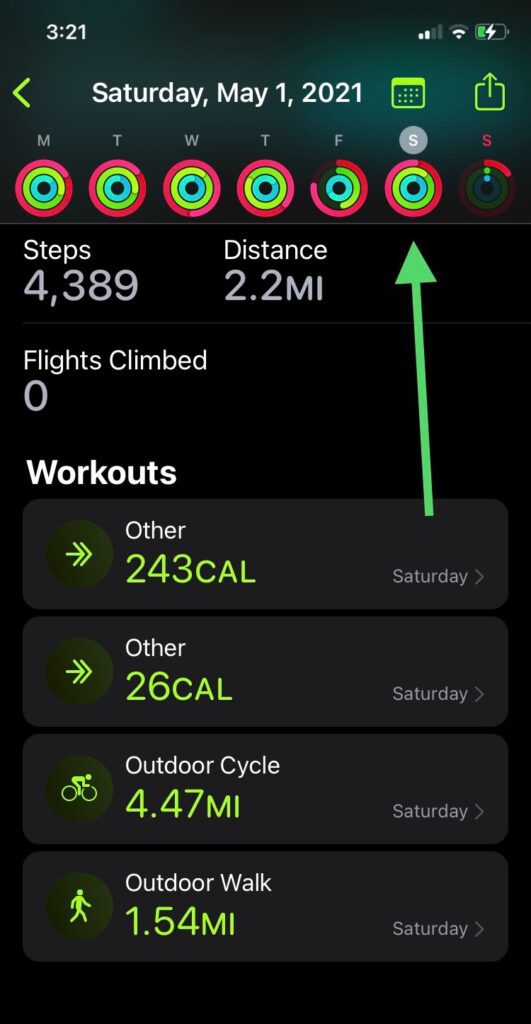Cycling does not count as exercise on the Apple Watch due to the user’s arm movements not being significant enough to register as physical activity. Cycling is a popular form of physical activity, but Apple Watch does not always accurately track it as exercise.
The reason lies in the limited movement of the user’s arms as they grip the handlebars, which may not meet the threshold for registering as exercise on the device. While cycling can still provide a beneficial workout, it is important to keep in mind that the Apple Watch may not always accurately reflect the effort put into this activity.
Understanding the limitations of technology can help users make informed decisions about tracking their fitness activities.
Misconceptions Surrounding Cycling And Exercise
When it comes to tracking exercise, Apple Watch has become a popular choice for fitness enthusiasts. However, there is a common misconception that cycling does not count as exercise on Apple Watch. In this blog post, we will explore the reasons behind this misconception and shed light on why cycling should be considered as a valuable exercise activity with the right understanding of Apple Watch metrics.
Inaccurate Data Measurement On Apple Watch
One of the key reasons for the misconception surrounding cycling and exercise on Apple Watch lies in the inaccurate data measurement. Unlike running or walking, where the motion is primarily detected by the wrist, cycling relies on the movement of the legs. As a result, the Apple Watch might not accurately capture the effort and intensity of cycling, leading to a lower count of exercise minutes or calories burned.
It is important to remember that Apple Watch uses built-in sensors and algorithms to estimate exercise metrics. Although it may not be perfect, Apple continues to refine its technology to provide users with more accurate measurements for all types of exercises, including cycling.
Different Metrics For Cycling Compared To Other Exercises
Another reason behind the misconception is the difference in metrics for cycling compared to other exercises on Apple Watch. When it comes to running or walking, the focus is primarily on the number of steps taken or the distance covered. However, cycling involves different metrics such as cadence, heart rate, and power output.
Cadence, which refers to the number of pedal rotations per minute, plays a crucial role in cycling. While the Apple Watch tracks heart rate accurately during cycling, it may not be able to accurately measure other metrics like cadence or power output. This can result in a perception that cycling is not being properly measured as an exercise activity on Apple Watch.
In conclusion, while there may be misconceptions surrounding cycling and exercise on Apple Watch, it is important to consider the nuances of data measurement and the specific metrics involved in cycling. With a deeper understanding of these factors, cyclists can still benefit from using Apple Watch to track their progress and achieve their fitness goals.
Credit: discussions.apple.com
Understanding Apple Watch’s Exercise Tracking
Apple Watch’s exercise tracking feature may not consider cycling as exercise due to its method of measuring movement and exertion. This can be attributed to the fact that cycling involves less arm movement, leading to a potential underestimation of your activity level.
Focus On Cardiovascular Activities
Apple Watch’s exercise tracking primarily focuses on cardiovascular activities. It tends to prioritize exercises that involve sustained elevated heart rates, such as running, brisk walking, and swimming. Cycling, which may not consistently elevate the heart rate, may not always be accurately recorded as exercise by the Apple Watch.
Importance Of Elevated Heart Rate
Elevated heart rate is crucial for effective exercise and calorie burning. Since cycling involves varied intensities and may not maintain a consistently high heart rate, Apple Watch may sometimes struggle to recognize it as a sustained exercise activity accurately.
Challenges In Accurately Measuring Cycling
The challenges in accurately measuring cycling for exercise tracking on the Apple Watch are often attributed to several factors. These challenges can impact the device’s ability to provide accurate and consistent data, causing frustration for cycling enthusiasts who rely on their smartwatches for fitness monitoring.
Variations In Cycling Intensity
Cycling encompasses a wide range of intensities, from leisurely rides to high-intensity sprints and hill climbs. The variation in cycling intensity poses a challenge for Apple Watch’s exercise tracking capabilities, as it can be challenging to accurately differentiate between different levels of exertion during a single cycling session.
Inconsistent Arm Movement Detection
One of the limitations of accurately measuring cycling on the Apple Watch is the inconsistent detection of arm movements. As the device relies on arm movement to gauge exercise, the nature of cycling – where the arms are relatively stationary – can lead to inaccurate readings and an underestimation of the actual exercise performed.
Improving Cycling Tracking On Apple Watch
Cyclists using Apple Watch may wonder why their cycling activities are not counted as exercise. Enhancements to cycling tracking on Apple Watch are necessary to accurately measure this form of physical activity.
Apple Watch is a popular wearable device that offers various health and fitness tracking features. However, when it comes to cycling, many users have found that it doesn’t accurately track their workouts. Whether you’re a casual cyclist or a serious athlete, having reliable data is crucial for tracking your progress and achieving your fitness goals. In response to user feedback, Apple has made efforts to improve cycling tracking on the Apple Watch with new updates and features.
Developing Cycling-specific Algorithms
To address the shortcomings in cycling tracking, Apple has been working on developing cycling-specific algorithms. These algorithms are designed to better understand the specific motions and patterns of cycling, enabling the Apple Watch to accurately measure metrics such as distance, speed, and calories burned.
Integration Of External Sensors
To provide an even more accurate and comprehensive cycling experience, Apple has also integrated external sensors with the Apple Watch. This integration allows users to connect compatible cycling sensors, such as speed sensors and cadence sensors, to their Apple Watch. By incorporating data from these sensors, the Apple Watch can provide more precise measurements and a more detailed analysis of your cycling workouts.
In addition to the improved tracking capabilities, the integration of external sensors also offers additional benefits. These sensors can provide real-time feedback on your performance, helping you adjust your cycling technique or pace for optimal results. They can also help you identify any areas where you may need to improve, whether it’s your cadence, power output, or overall efficiency.
With the development of cycling-specific algorithms and the integration of external sensors, Apple is committed to enhancing the cycling tracking experience on the Apple Watch. These improvements aim to give cyclists the accurate and detailed data they need to track their progress, set new goals, and ultimately improve their overall fitness and performance.
Alternative Fitness Tracking Options For Cyclists
Are you an avid cyclist who relies on your Apple Watch for fitness tracking? Have you ever wondered why cycling doesn’t count as exercise on your Apple Watch? While the Apple Watch is known for its accurate tracking capabilities, it doesn’t always recognize cycling as a workout. But don’t worry, there are alternative fitness tracking options for cyclists that can help you keep track of your cycling activities.
Dedicated Cycling Fitness Trackers
If you want a tracking device specifically designed for cyclists, consider investing in a dedicated cycling fitness tracker. These devices are specially built to track cycling metrics accurately and provide insightful data about your performance. Most dedicated cycling fitness trackers come with features like GPS tracking, heart rate monitoring, cadence tracking, and even advanced metrics such as power output. These trackers can offer a more comprehensive analysis of your cycling workouts than the Apple Watch alone.
Third-party Apps With Accurate Cycling Metrics
Another option for tracking your cycling activities is to use third-party apps that offer accurate cycling metrics. These apps can be easily installed on your Apple Watch and provide more detailed data about your rides. Some popular third-party apps for cycling include Strava, Endomondo, and Cyclemeter. These apps utilize GPS technology to track your route, speed, distance, and elevation accurately. Additionally, they may offer features like segment tracking, virtual competitions, and social sharing to enhance your cycling experience.
Combining these third-party apps with your Apple Watch can give you the best of both worlds – accurate fitness tracking and advanced cycling metrics. Simply connect your Apple Watch to these apps, start your cycling workout tracking, and let them do the rest. You’ll have access to detailed insights and analysis that go beyond what the Apple Watch can provide on its own.
Remember, while the Apple Watch may not recognize cycling as exercise out of the box, there are alternative options available to track your cycling activities accurately. Whether you choose to invest in a dedicated cycling fitness tracker or utilize third-party apps on your Apple Watch, you can still enjoy the benefits of tracking your cycling workouts and monitoring your progress. So, get out there, hit the road, and let these alternative fitness tracking options enhance your cycling experience.
Frequently Asked Questions For Why Doesn’t Cycling Count As Exercise On Apple Watch
Why Doesn’t Cycling Count As Exercise On Apple Watch?
Cycling may not count as exercise on Apple Watch because the device has specific algorithms to identify and track different types of physical activity. Cycling may not trigger the necessary motion sensors or heart rate patterns that Apple Watch recognizes as exercise.
However, you can still manually log your cycling workouts in the “Workout” app to track your progress.
How Accurate Is Apple Watch For Tracking Cycling?
While Apple Watch may not track cycling automatically, you can use the “Workout” app to manually start and track your cycling workouts. The device uses a combination of GPS and heart rate monitoring to provide accurate data on your distance, pace, and calories burned.
Ensure that you have a good GPS signal, wear the watch snugly, and start the workout before cycling.
Can I Add Cycling As A Workout On Apple Watch?
Yes, you can add cycling as a workout on Apple Watch by using the “Workout” app. Open the app, select “Outdoor Cycle” or “Indoor Cycle” based on your activity, and tap “Start. ” This way, you can manually track your cycling workouts and receive accurate metrics such as distance, pace, heart rate, and calories burned.
How Can I Improve The Accuracy Of Apple Watch For Cycling?
To improve the accuracy of Apple Watch for cycling, ensure that you have a strong GPS signal, wear the watch snugly, and start the workout before cycling. Additionally, consider using a Bluetooth-enabled bike cadence sensor that can pair with your Apple Watch.
This can provide more precise data on your cycling speed and help improve the overall accuracy of your workouts.
Conclusion
While the Apple Watch is a powerful fitness tool, its definition of exercise may not align with all activities. Cycling, for example, may not be recognized as exercise due to the way the watch measures activity. However, it’s crucial to remember that the fitness tracker is just a tool and should not undermine the value of cycling as a valid form of exercise.
Ultimately, listening to your body and prioritizing personal well-being is key, regardless of what the Apple Watch may track.



